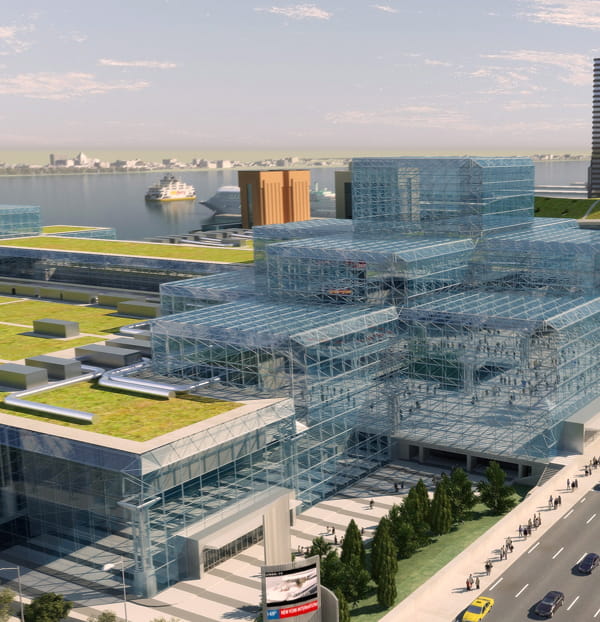Green Roof Javits Center

- Bolstered by Research Consortium with Drexel, Jefferson’s Sidney Kimmel Cancer Center Earns NCI Comprehensive Cancer Center Designation
- Alyssa Kemp Named as 2024 Truman Scholar
- No link between acetaminophen use during pregnancy and children's autism risk
- Drexel Recognizes Gregory E. Deavens, CPA, CGMA as Business Leader of the Year

In what is estimated to be one of the largest green retrofitting projects in U.S. history, a makeover of the Jacob K. Javits Convention Center is underway in New York City. The cost of the transformation is on the order of $463 million. While the effects that the green technology will have on the massive convention center and its surrounding environment are not yet known, they will, however, be closely monitored by a team of engineers from Drexel University and The Cooper Union for the Advancement of Science and Art.
The 6.75-acre green roof is the centerpiece of a series of renovations designed to make the 27-year-old building an example of retrofitting for sustainability. When it opened in 1986 the Javits Center was –according to many architects—outdated by sustainable by sustainable design measures- before it even opened.
“In the last few years, the City of New York has made major commitments to sustainability and to different forms of green infrastructure,” said Dr. Franco Montalto, a professor at Drexel’s College of Engineering and the lead researcher. “The Javits Center green roof exemplifies the kind of environmentally sensible urban redevelopment projects that the City wants to encourage. The retrofit building will reduce urban runoff, mitigate the urban heat island effect, and, potentially have a cooling effect on the streets and buildings that surround it. Our research will seek to quantify these benefits.”
Under the direction of FXFOWLE Epstein, New York, N.Y., a joint venture between FXFOWLE Architects and Epstein, the Javits Center has embarked on a major renovation project that includes replacement of the building’s curtain wall, upgrades to the mechanical and electrical systems, and interior reconfigurations that will enhance the visitor experience as well as operational efficiency. These modifications are in addition to the green roof, which, at 292,000 square feet, will be second largest green roof on a single, free standing building in the United States.
As part of the research study, four climate stations will be installed on and around the green roof; flumes, thermistors, soil sensors and a series of weighing lysimeters will be installed within the green roof itself. Together, these instruments will be used to evaluate what effect the green roof is having on its immediate microclimate, how much rainwater ultimately runs off and/or evaporates from its surface, and to what extent the roof -and the intake for the convention center’s air conditioning system- is cooler once the vegetation is in place.
The design and installation of the sensor system will be led by Montalto’s research team, which is currently also monitoring more than 15 other green infrastructure sites in New York, New Jersey, and Pennsylvania. Students from The Cooper Union will monitor the data and use it to learn about and model functional sustainable design projects.
“The Javits Center green roof project provides Cooper Union students with a significant learning opportunity to study sustainable design and use New York City as a learning laboratory,” said Dr. Joseph Cataldo, a professor in the Albert Nerken School of Engineering at The Cooper Union. “Our students are presently developing a model to predict the thermal behavior of the green roof using climate and infrared data. This information will be helpful to better gauge hydrology and temperature variations of the green roof, which, subsequently, is an important part of determining and understanding temperature patterns in green roofs and New York City as a whole.”
The architects at FXFOWLE Epstein predict that the renovations will decrease the center’s energy consumption by as much as 26 percent.
“Water and energy are intimately linked through the process of evapotranspiration,” Montalto said. “Incident solar radiation changes liquid water, originally deposited on the roof by precipitation, into water vapor which then leaves the roof surface. The energy consumed by this process keeps the roof and building cooler than it otherwise would be, since without the green roof this energy would simply heat up the roof surface. At the same time, if the air in the vicinity of the air conditioner intake pipes is cooler, these units have to work less to cool the -already cooler- building.”
Drexel News is produced by
University Marketing and Communications.